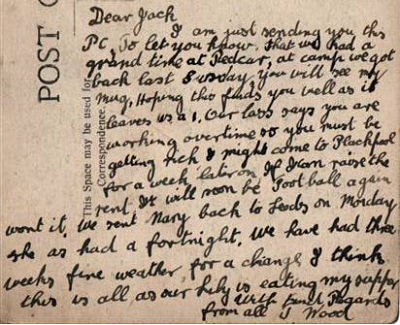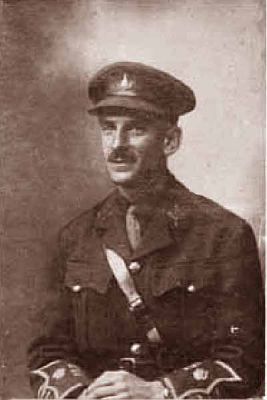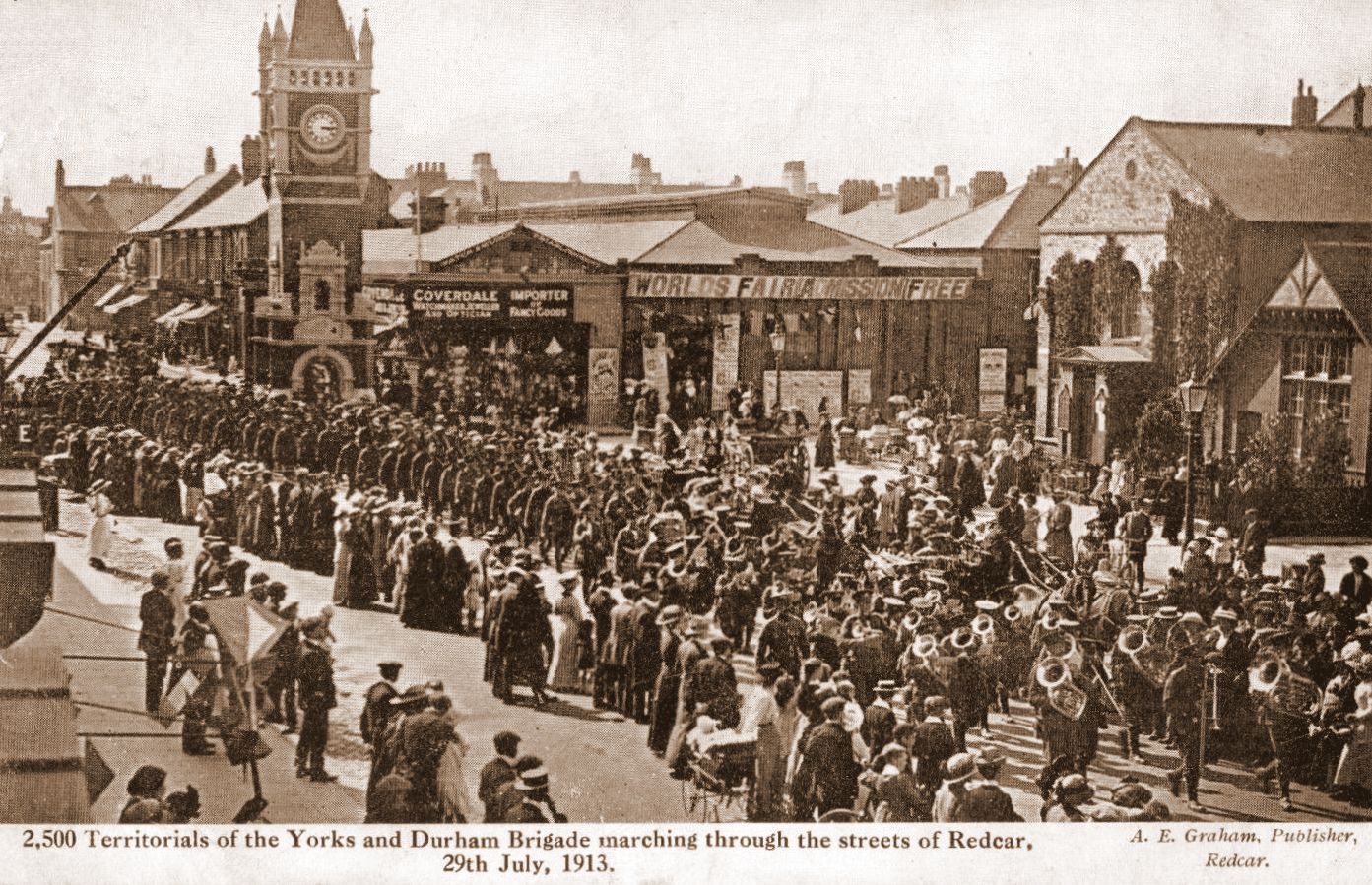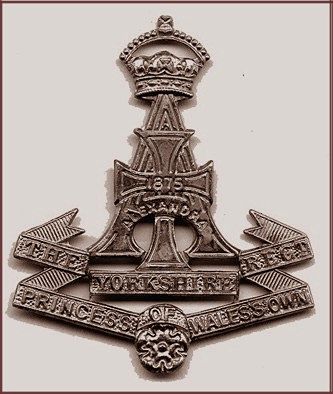 Men of the 4th Yorks at the 1913 Annual Camp, Redcar, N Yorks.
Men of the 4th Yorks at the 1913 Annual Camp, Redcar, N Yorks.
Second from Right standing is Fred Appleton. One of the others is Thomas Wood, age 24. He was killed
in action on the 3rd May 1915 at Ypres. [Photo kindly donated by Thomas's Great Nephew, John Simpson of Lympne, Kent.]
|
26th JULY.
The annual Camp of the Durham and York Brigade was held in Redcar, N Yorks. It was sited on 80 acres of land at Ings
and Wheatlands Farms. The Directors of the Racecourse offered the greater part of their ground and surrounding landowners
gave similar permission for training activities.
Men of The 4th Yorks Btn from the nearby towns and villages of East Cleveland marched in.
Six special trains brought the rest. By Sunday night 900 men of the Battalion were in Camp.
These were joined by 750 from the Hull area, who comprised the 4th East Yorks Btn;
700 from South Durham who formed the 5th Btn of the Durham Light Infantry;
650 from the Scarborough area who made up
the 5th Btn of the Yorkshire Regiment.
In addition there were 250 men of the 3rd Northumbrian Field Ambulance, 82 of the Army Service Corps and a dozen with the
Ordnance Corps.
In all 3,000 men gathered together under canvas for 15 days of military training.
At the same time a naval exercise was in progress off the coast.
Local papers mention that a watch was being kept on the coast in the Humber area and
�at the mouth of the Tees there are now on the watch both artillery and engineer units.�
|
 Postcard sent by Thomas Wood on his return from the 1913 Annual Camp at Redcar.
Postcard sent by Thomas Wood on his return from the 1913 Annual Camp at Redcar.
|
It appears Germany�s build up of naval and military power was already causing concern.
For many of the men, this fortnight of training was their annual holiday from the mines, steelworks, factories or hard
graft on the land.
"Crowds of residents, old as well as young, turned out to greet them as they passed through the main streets to their
quarters, and the decorations of the principal thoroughfare of the town was evidence of the satisfaction felt at the
selection of Redcar for another Brigade camp, [which was the centre of public attention for the next fortnight.]"
After settling in to their tents the men were given the rest of the day off and Redcar �presented the appearance of a
garrison town, the soldiers helping to swell the already large crowd on the promenade.�
Many of the men were new recruits and the first week was given over to Company training with Signalling, Rifle drill
and Machine Gun exercises. Sports events were held and nightly concerts given.
Entertainment by girls from the Redcar Wesleyan Sunday School and a mouth organ competition was typical of the decent
innocence of the time. On the Victorian surface.
The Camp also included YMCA tents, a Savings Bank and a Post Office.
The York and Durham Brigadier was Colonel J.E. Bush, with Capt. R.F. Guy as Brigade-Major.
The officers present from the 4th Yorks Btn were :
|
 Capt Robert Alfred Constantine.
Capt Robert Alfred Constantine. |
Capt Robert Alfred Constantine.
One of the three Constantine brothers of Harlsey Hall, East Harlsey, Northallerton.
They were all Officers in the 4th Yorks Bn and are mentioned throughout this website.
Robert was born 5 April 1885 and educated at Uppingham before entering the family shipping business.
He was a Captain in the Battalion prior to the War but was medically unfit to deploy to France in April 1915.
He was promoted to Temporary Major in September 1915, working with the Provisional Battalions.
He was confirmed as a Major in June 1916 and deployed to France serving as an Equipment Officer/Technical Officer with the Royal Flying Corps.
[Photograph and information was kindly contributed by his Great Nephew, Simon Barnard.]
The CO, Lieut Colonel W H A Wharton of Skelton Castle, Major the
Hon W G A Orde-Powlett, M.P., Major Maurice Bell, Captain and Adjutant G D P Eykyns [25 April 1915], Captains
H C Matthews [25 April 1915], G J E Gardner, H G Scott, B Jackson, H R French, A Graham, R A Constantine, and
G H Bowes-Wilson [15 June 1915]: Major H L de Legh and Captain Whitehead (R.A.M.C.), Chaplains Holmes and Perkins,
and Lieut and Quartermaster W H Colton.
Dates in brackets are when these men were killed in the War to come.
29th JULY. In response to the fine welcome Redcar had given the Brigade a special parade was arranged for Tuesday
with the soldiers led by their Bands marching through the town.
�The procession was headed by the band of the 4th Yorkshires, Colonel Bush and Captain Guy riding in front. The esplanade
was traversed and the men then proceeded by way of Newcomen Street, Lobster-road, Coatham-road and back to camp by way
of the High Street and Redcar Lane.�
|

|
3rd AUG. On Sunday, after a religious service, the Brigade were inspected by General Bethune, Director-general
of the Territorial Forces, who motored over from Rounton Grange with Sir Hugh Bell, the Lord Lieutenant of the North
Riding and President of the North Riding Territorial Association.
The General was also asked to present a number of medals to the following men of the 4th Yorks.
One for good conduct was handed to Sergt.-Instructor Chettleburgh of Stokesley.
[He was killed as a CSM on the 27th May 1918].
Efficiency medals were presented to Sgt Wilkinson,
of Middlesbrough; Sergt.Headland, Stokesley and Private Watts of Yarm.
6th AUG. General Burton, commanding the Northumbrian Division of Territorials, visited the camp, and spent the
whole day with the Brigade. �He motored to the hilly district by Upleatham, and saw the 4th Yorkshire Battalion, who
were engaged in a scheme of attack, and which was executed very well.�
|
8th AUG. On the last Friday the main event of the two-week Camp took place.
After breakfast all the units made a stiff, seven mile march out to Eston Moor, where they were due by 10 o�clock to
carry out a practice attack under the eye of Major-General Burton.
�The 5th Durhams were entrusted with the defence of the west side of Wilton Plantation, and the attack was delivered
by the 4th and 5th Yorkshires and the 4th East Yorkshires from the direction of Upsall.�
|
 |
|  |
In April 1915 the majority of these same men would be at Ypres, marching toward a cloud of poisonous gas and a hail of German
shells and bullets.
9th August. Brigade drill was carried out and the Camp ended with a march past. All the men returned to their
homes the following day.
Herbert Pigg of West Tce, Skelton.
He won a recruits' Shooting Cup in 1908, served with the Battalion throughout the War and survived. He spent all of October
1916 in Hospital in Reading with a gunshot wound and in May 1918 was again Hospital at Hornsea with Gastritis.
He afterwards worked for Skelton Castle and was for a longtime the village Scoutmaster, living to be over 80.
Webpage about him here.
[Photograph, which appears to be pre-War, was kindly donated by his Great Nephew, John Richardson.]
|
|



